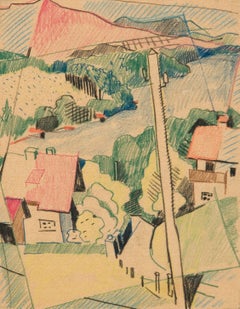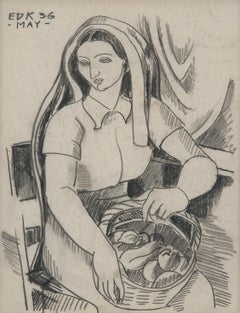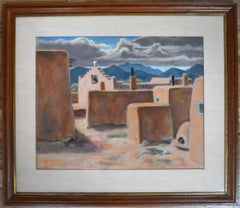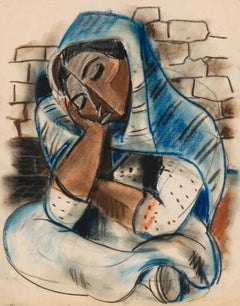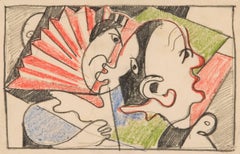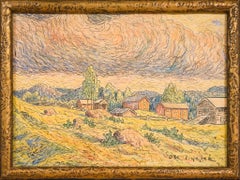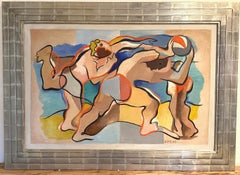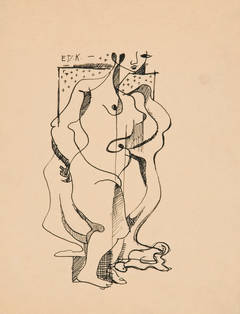Edmund Daniel Kinzinger Art
to
5
5
5
4
1
Untitled
By Edmund Daniel Kinzinger
Located in Dallas, TX
Edmund D. Kinzinger was born in 1888, in Pforzhein, Germany. In Munich he studied at the Kirr Schule and the Staatliche Akademie, and pursued graduate studies at the Academie Modern, Paris. Before serving in the German Army, Kinzinger was a master student of Adolph Holzel at the Staatcliche Akademie, Stuttgart; he returned to study under Henrich Waldschmidt after nearly five years of artillery service.
Several of Kinzinger’s fellow students in Germany, such as Johannes Itten, would go on to be associated with the Bauhaus school. Coming into contact with all manner of artistic influences in Europe after World War One, Kinzinger’s work may be viewed as a “synthesis” of modernist styles. The influences of Abstract Expressionist, Cubist, and Futurist styles in Kinzinger’s work at this time are symptomatic of his contact with the likes of Hans Hofmann, Pablo Picasso, and Alexander Archipenko.
About this period of Kinzinger's work, Philip Van Keuren...
Category
1930s Cubist Edmund Daniel Kinzinger Art
Materials
Crayon, Paper, Pencil
Untitled
By Edmund Daniel Kinzinger
Located in Dallas, TX
Edmund D. Kinzinger was the Chairman of the Art Department at Baylor University from 1935 to 1950. Previously, Kinzinger was the Director of the Hans Hofmann School of Fine Arts in Munich. Kinzinger left Germany in 1933 because he did not agree with the Nazi government. Kinzinger’s early work in Germany was influenced by Theosophy: a philosophy based on mystical insight into the nature of God. This guided Kinzinger’s art away from representation and towards abstraction. Later, Kinzinger assimilated German Expressionism, French Cubism, and Italian Futurism with his own continuing sense of the mystery of life. While his work incorporated the formal qualities of cubism, there was always a mystical moodiness just below the surface.
"From EDK: The Early Years 1913-1935" by Philip Van Keuren...
Category
1930s Edmund Daniel Kinzinger Art
Materials
Conté, Paper
"ADOBE CHURCH" NEW MEXICO DATED 1943 FRAMED 28.75 X 33.25
By Edmund Daniel Kinzinger
Located in San Antonio, TX
Edmund Daniel Kinzinger
(1888-1963)
Waco Artist
Image Size: 18.5 x 24
Frame Size: 28.75 x 33.25
Medium: Pastel
Dated 1943
"Adobe Church" New Mexico
Biography
Edmund Daniel Kinzinger ...
Category
1940s Impressionist Edmund Daniel Kinzinger Art
Materials
Pastel
Untitled (Woman Resting)
By Edmund Daniel Kinzinger
Located in Dallas, TX
Edmund D. Kinzinger was born in 1888, in Pforzhein, Germany. In Munich he studied at the Kirr Schule and the Staatliche Akademie, and pursued graduate studies at the Academie Modern, Paris. Before serving in the German Army, Kinzinger was a master student of Adolph Holzel at the Staatcliche Akademie, Stuttgart; he returned to study under Henrich Waldschmidt after nearly five years of artillery service.
Several of Kinzinger’s fellow students in Germany, such as Johannes Itten, would go on to be associated with the Bauhaus school. Coming into contact with all manner of artistic influences in Europe after World War One, Kinzinger’s work may be viewed as a “synthesis” of modernist styles. The influences of Abstract Expressionist, Cubist, and Futurist styles in Kinzinger’s work at this time are symptomatic of his contact with the likes of Hans Hofmann, Pablo Picasso, and Alexander Archipenko. Philip Van Keuren...
Category
1930s Modern Edmund Daniel Kinzinger Art
Materials
Conté, Paper, Pastel
Untitled
By Edmund Daniel Kinzinger
Located in Dallas, TX
Edmund D. Kinzinger was born in 1888, to an upper-middle class family in Pforzhein, Germany. In Munich he studied at the Kirr Schule and the Staatliche Akademie, and pursued graduate studies at the Academie Modern, Paris. Before serving in the German Army, Kinzinger was a master student of Adolph Holzel at the Staatcliche Akademie, Stuttgart; he returned to study under Henrich Waldschmidt after nearly five years of artillery service.
Several of Kinzinger’s fellow students in Germany, such as Johannes Itten, would go on to be associated with the Bauhaus school. Coming into contact with all manner of artistic influences in Europe after World War One, Kinzinger’s work may be viewed as a “synthesis” of modernist styles. The influences of Abstract Expressionist, Cubist, and Futurist styles in Kinzinger’s work at this time are symptomatic of his contact with the likes of Hans Hofmann, Pablo Picasso, and Alexander Archipenko. Philip Van Keuren...
Category
1930s Cubist Edmund Daniel Kinzinger Art
Materials
Conté, Crayon, Paper
Related Items
A Northern Vision in Miniature
Located in Stockholm, SE
This exquisitely detailed drawing by Swedish artist Oscar Lycke captures a rustic settlement nestled in the golden highlands of northern Sweden, most likely depicting the traditional...
Category
1910s Impressionist Edmund Daniel Kinzinger Art
Materials
Paper, Crayon, Watercolor, Pencil
Self Portrait Sketch
By Ben Fenske
Located in Sag Harbor, NY
An early work on paper, by American Impressionist painter, Ben Fenske. It's rare to see a drawing like this from Fenske, especially of a self portrait. Fenske uses classical draftin...
Category
Early 2000s Academic Edmund Daniel Kinzinger Art
Materials
Paper, Conté
Penny Stars and Clouds (Matisse Inspired Drawing on Collaged Vintage Book Pages)
Located in Hudson, NY
Penny Stars and Clouds (Matisse-like Drawing on Collaged Vintage Book Pages) by Louise Laplante
2024
pastel and collaged vintage Penny Magazines and chalk
23.75 x 24.50 inches unfram...
Category
2010s Contemporary Edmund Daniel Kinzinger Art
Materials
Paper, Chalk, Pastel
$2,850
H 27 in W 28 in D 2 in
MB 005 (Modern, Traditional Style Figurative Life Drawing of Muscular Male Nude)
By Mark Beard
Located in Hudson, NY
Figurative nude drawing on Arches paper
graphite, conte crayon and charcoal on Arches paper
22 x 15 inches unframed
Contemporary figurative life study drawing of a reclining male nu...
Category
2010s Modern Edmund Daniel Kinzinger Art
Materials
Conté, Graphite
19th century pastel of a river scene, The Chapel Bridge, Lucerne, Switzerland.
By Hercules Brabazon Brabazon
Located in Cotignac, FR
Mid 19th century pastel drawing view of the Chapel Bridge and river Reuss in Lucerne, Switzerland by Hercules Brabazon Brabazon. The work...
Category
1860s Edmund Daniel Kinzinger Art
Materials
Paper, Pastel, Pencil
Untitled (Man Reclining on Tile Floor)
By Mark Beard
Located in New York, NY
Graphite and conté crayon on paper
Signed and dated, l.r.
This artwork is offered by ClampArt, located in New York City.
Mark Beard, born in 1956 in Salt Lake City, now lives in Ne...
Category
1970s Realist Edmund Daniel Kinzinger Art
Materials
Paper, Graphite, Conté
Young man in a toga elegant man Latin American hyperrealist Hockney style
By Claudio Bravo
Located in Norwich, GB
Superb original drawing in coloured conté pencils, heightened with white on oatmeal coloured vergé paper by Claudio Bravo. The work was created during the artist's Moroccan period, a...
Category
1970s Modern Edmund Daniel Kinzinger Art
Materials
Conté, Laid Paper, Color Pencil
$7,500
H 30.32 in W 24.02 in D 0.4 in
Bellagio, Lake Como. Pastel.
By Hercules Brabazon Brabazon
Located in Cotignac, FR
Mid 19th century pastel drawing view of Bellagio on Lake Como by Hercules Brabazon Brabazon. The work is under its original mount and initial signed (HBB) b...
Category
1860s Edmund Daniel Kinzinger Art
Materials
Paper, Pastel, Pencil
Modernist Conte Crayon Drawing Beach Scene David Burliuk Russian Futurist
By David Burliuk
Located in Surfside, FL
David Burliuk (Ukrainian, 1882-1967)
Three figure on the beach (Hamptons, Long Island New York)
Conte crayon drawing on paper.
Hand signed lower left.
Unframed
Provenance: Bloomsbury Auctions
David Davidovich Burliuk (Дави́д Дави́дович Бурлю́к; 1882-1967) was a Russian poet, artist and publicist of Ukrainian origin associated with the Futurist and Neo-Primitivist movements. Burliuk has been described as "the father of Russian Futurism."
David Burliuk was born on 21 July 1882 in the village of Riabushky (near Lebedyn, Ukraine) in the Kharkov Governorate of the Russian Empire. Burliuk's family was artistically inclined; two of his brothers were talented artists as well, Nikolai and Volodimir Burliuk. The Burliuk family partly descended from Ukrainian Cossacks on their father's side, who held premier positions in the Hetmanate. His mother, Ludmyla Mikhnevich, was of ethnic Belarusian descent.
From 1898 to 1904, he studied at Kazan and Odesa art schools, as well as at the Royal Academy in Munich. His exuberant, extroverted character was recognized by Anton Azhbe, his professor at the Munich Academy, who called Burliuk a "wonderful wild steppe horse". During a time of significant industrialization and political change, movements such as the famed Der Blaue Reiter, a group Burliuk associated with in 1912, while he was in Munich, emphasized a shift away from the classical styles of the past, prioritizing the innovations of the future.
In 1907, he made contact with the Russian art world; he met and befriended Mikhail Larionov, and they are both credited as being major forces in bringing together the contemporary art world. In 1908, an exhibition with the group Zveno ("The Link") in Kiev was organized by David Burliuk together with Wladimir Baranoff-Rossine, Alexander Bogomazov, his brother Volodymyr (Wladimir) Burliuk and Aleksandra Exter. The exhibition was a flop, especially because they were all unknown painters. The Burliuks and Larionov left for the aforementioned brothers' home in Chernianka, also known as Hylea; it was during this stay that their work became more Avant-Garde. That autumn, while visiting Ekster, they organized an exhibition which took place in the street; it was a success, and enough money was raised to go to Moscow.
In 1909, Burliuk painted a portrait of his future wife, Marussia, on a background of flowers and rocks...
Category
Mid-20th Century American Modern Edmund Daniel Kinzinger Art
Materials
Paper, Conté, Crayon
A Dynamic 1945 Mid-Century Modern Cubist Studio Scene, Artist Sketch Class
By Harold Haydon
Located in Chicago, IL
A Dynamic, 1945 Mid-Century Modern Cubist Studio Scene, Artist's Sketch Class by Noted Chicago Painter, Harold Haydon (Am. 1909-1994). Artwork size: 11 x 8 1/2 inches, unframed, mo...
Category
Mid-20th Century Cubist Edmund Daniel Kinzinger Art
Materials
Paper, Charcoal, Pastel
$385
H 15 in W 12 in D 0.13 in
Female Nude, Pastel and Chalk Study for a Sculpture
Located in Cotignac, FR
A chalk and crayon study for a scuplture by French female artist Marie-Josèphe Bourron. Presented in modern frame with mount under glass. Though not signed the drawing was acquired d...
Category
Late 20th Century Realist Edmund Daniel Kinzinger Art
Materials
Paper, Chalk, Crayon, Pastel
$792
H 25.2 in W 20.08 in D 0.79 in
The Great Escape by Patsy McArthur - unique charcoal on paper - white box frame
By Patsy McArthur
Located in Dallas, TX
This is a beautiful and unique charcoal on paper drawing. The Fabriano paper is a high quality watercolour grade set in a custom white wood frame, all archival materials.
Scottish ...
Category
2010s Realist Edmund Daniel Kinzinger Art
Materials
Conté, Charcoal, Archival Paper
$4,160 Sale Price
24% Off
H 32.29 in W 50.4 in D 1.58 in
Previously Available Items
"AT THE BEACH" 1934 MODERN MASTERPIECE WACO TEXAS BAYLOR UNIVERSITY CHAIRMAN
By Edmund Daniel Kinzinger
Located in San Antonio, TX
Edmund Daniel Kinzinger
(1888-1963)
Waco Artist
Image Size: 26 x 39
Frame Size: 34 x 48
Medium: Oil
Dated 1934
"At The Beach"
Biography
Edmund Daniel Kinzinger (1888-1963)
Kinzinger, Edmund Daniel. 1888-1963. Waco. Painter, sculptor, graphic artist, teacher.
Kinzinger was born a Pforzheim, Grand Duchy Baden, German Empire, and attended the Knirr Schule, Munich (1908-10), Followed by periods at the Staatliche Akademie, Munich (1909-10), and the Staatliche Akademie, Stuttgart (1910-12). He was a graduate student at the Academie Moderne, Paris (1912-13), and a master student of Adolph Holzel at the Staatliche Akademie, Stuttgart (1913-14, supporting himself by painting portraits. Entering the German army in 1914 as a private soldier, Kinzinger rose after nearly five years at the front , and two wounds, to command an artillery unit, Released from active service in 1918, he studied as a master student of Henrich Waldschmidt, again at the staatliche Akademie, Stuttgart (1919-21).
From 1924 to 1928, Kinzinger taught in Munich, where he met Alice Fish Kinzinger, an American; they were married in 1927. Kinzinger traveled to the United States to teach at the Minneapolis Art Institute in the summer of 1928 and then at the Minneapolis Art Students League (1929-30). He painted in Taxco, Mexico, in the summer of 1930. From 1930 until 1933, Kinzinger was director of the Hans Hoffman Schule fur Bildende Kuntz, Munich, and the Hofmann Self-Study Course in California. During the same period, he taught in Spain and St. Tropez, France. He also served as director of the Ecole de lEpoque, Paris (1933-34).
Fleeing Nazi Germany, Kinzinger came again to the United States and in 1935 became chairman of the art department at Baylor University, Waco, a position he would hold for the next thirteen years. In the years 1939-42), Kinzinger attended summer sessions at the University of Iowa City, and his dissertation--a series of paintings on a Mexican theme--earned for him in 1942 the first doctorate in fine arts conferred by the University of Iowa. Beginning in 1944, Kinzinger painted summers in Taos. Troubled by depression for a number of years, Kinzinger was divorced in 1947 and stopped painting in 1948 when he moved to live with his son in Delavan, Wisconsin. After 1960 he was a resident of North Carolina where he died of a stroke. Exhibitions: Galerie Pierre, Paris (1933 one-man); Bloomsbury Gallery, London (1933 one-man); Rouillier Gallery, Chicago (1935); Art Institute of Chicago (1935 one man,1938); Texas Centennial Exposition, Dallas (1936); Greater Texas and Pan-American Exposition, Dallas (1937); Dallas School of Creative Arts (1937); Witte Memorial Museum, San Antonio (1937 and 1944 one-man); Annual Southeast Texas Artist Exhibition, Houston (1937,1938,and 1939 honorable mentions); Museum of Fine Arts, Houston (1937 one-man); National Exhibition of American Arts, Rockefeller Center, New York (1937-38); Three German Painters (1938), Two Hundred Years of American Art (1946), Dallas Museum of Fine Arts; Golden Jubilee Exposition, State Fair of Texas, Dallas (1938); American Art Today Exhibition, New York World's Fair (1939); Dallas Museum of Fine Arts (1939 and 1942 one-man, 1945, 1971); Golden Gate International Exposition, San Francisco (1939-40); Corcoran Gallery of Art, Washington, D.C. (1939); Annual Exhibition of West Texas Artist, Fort Worth Museum of Art (1939, 1940 prize); Lone Star Printmakers Circuit Exhibition (1940-42); Texas General Exhibition (1940-42, 1943 award, 1944-45, 1947 award); Southern States Art League Annual Exhibition (1941-42); Texas-Oklahoma General Exhibition (1941); Annual Texas Artists Circuit Exhibition (1943 prize, 1944 honorable mention,1945,1948); Annual Texas Print Exhibition, Dallas (1943 award, 1944, 1947 award); International Exhibition of Prints and Drawings, Elisabet Ney...
Category
1930s Impressionist Edmund Daniel Kinzinger Art
Materials
Mixed Media, Oil
Untitled
By Edmund Daniel Kinzinger
Located in Dallas, TX
Edmund D. Kinzinger was born in 1888, to an upper-middle class family in Pforzhein, Germany. In Munich he studied at the Kirr Schule and the Staatliche Akademie, and pursued graduate...
Category
1930s Cubist Edmund Daniel Kinzinger Art
Materials
Ink, Paper, Pen
Bajadere
By Edmund Daniel Kinzinger
Located in Dallas, TX
Edmund D. Kinzinger was born in 1888, in Pforzhein, Germany. In Munich he studied at the Kirr Schule and the Staatliche Akademie, and pursued graduate studies at the Academie Modern, Paris. Before serving in the German Army, Kinzinger was a master student of Adolph Holzel at the Staatcliche Akademie, Stuttgart; he returned to study under Henrich Waldschmidt after nearly five years of artillery service.
Several of Kinzinger’s fellow students in Germany, such as Johannes Itten, would go on to be associated with the Bauhaus school. Coming into contact with all manner of artistic influences in Europe after World War One, Kinzinger’s work may be viewed as a “synthesis” of modernist styles. The influences of Abstract Expressionist, Cubist, and Futurist styles in Kinzinger’s work at this time are symptomatic of his contact with the likes of Hans Hofmann, Pablo Picasso, and Alexander Archipenko. Philip Van Keuren writes:
“His work closely resembles that of his contemporaries except for the mystical moodiness that seems to lay just under the surface of even the most non-objective works from this period. Their poetic mood springs less from his use of saturated, luminous colors and evocative forms and more from some undeniable power of perception drawn from his sense of the mystery of life. This mystic moodiness has its roots in personal inspirations. In this, Kinzinger drew upon German landscape painting...
Category
1930s Modern Edmund Daniel Kinzinger Art
Materials
Paper, Pencil
Fishermen
By Edmund Daniel Kinzinger
Located in Dallas, TX
This is signed by the artist "EDK 32" at lower right.
Edmund D. Kinzinger was born in 1888, to an upper-middle class family in Pforzhein, Germany. In Munich he studied at the Kirr...
Category
1930s Modern Edmund Daniel Kinzinger Art
Materials
Paper, Pencil
Untitled (Fisherman Carrying Jug and Basket)
By Edmund Daniel Kinzinger
Located in Dallas, TX
Edmund D. Kinzinger was born in 1888, in Pforzhein, Germany. In Munich, he studied at the Kirr Schule and the Staatliche Akademie, and pursued graduate studies at the Academie Modern...
Category
1930s Modern Edmund Daniel Kinzinger Art
Materials
Conté, Crayon, Paper
Untitled
By Edmund Daniel Kinzinger
Located in Dallas, TX
Edmund D. Kinzinger was born in 1888, to an upper-middle class family in Pforzhein, Germany. In Munich he studied at the Kirr Schule and the Staatliche Akademie, and pursued graduate studies at the Academie Modern, Paris. Before serving in the German Army, Kinzinger was a master student of Adolph Holzel at the Staatcliche Akademie, Stuttgart; he returned to study under Henrich Waldschmidt after nearly five years of artillery service.
Several of Kinzinger’s fellow students in Germany, such as Johannes Itten, would go on to be associated with the Bauhaus school. Coming into contact with all manner of artistic influences in Europe after World War One, Kinzinger’s work may be viewed as a “synthesis” of modernist styles. The influences of Abstract Expressionist, Cubist, and Futurist styles in Kinzinger’s work at this time are symptomatic of his contact with the likes of Hans Hofmann, Pablo Picasso, and Alexander Archipenko. Philip Van Keuren wrote:
“His work closely resembles that of his contemporaries except for the mystical moodiness that seems to lay just under the surface of even the most non-objective works from this period. Their poetic mood springs less from his use of saturated, luminous colors and evocative forms and more from some undeniable power of perception drawn from his sense of the mystery of life. This mystic moodiness has its roots in personal inspirations. In this, Kinzinger drew upon German landscape painting...
Category
1930s Cubist Edmund Daniel Kinzinger Art
Materials
Paper, Pencil
Untitled
By Edmund Daniel Kinzinger
Located in Dallas, TX
Edmund D. Kinzinger was born in 1888, to an upper-middle class family in Pforzhein, Germany. In Munich he studied at the Kirr Schule and the Staatliche Akademie, and pursued graduate studies at the Academie Modern, Paris. Before serving in the German Army, Kinzinger was a master student of Adolph Holzel at the Staatcliche Akademie, Stuttgart; he returned to study under Henrich Waldschmidt after nearly five years of artillery service.
Several of Kinzinger’s fellow students in Germany, such as Johannes Itten, would go on to be associated with the Bauhaus school. Coming into contact with all manner of artistic influences in Europe after World War One, Kinzinger’s work may be viewed as a “synthesis” of modernist styles. The influences of Abstract Expressionist, Cubist, and Futurist styles in Kinzinger’s work at this time are symptomatic of his contact with the likes of Hans Hofmann, Pablo Picasso, and Alexander Archipenko. Philip Van Keuren wrote:
“His work closely resembles that of his contemporaries except for the mystical moodiness that seems to lay just under the surface of even the most non-objective works from this period. Their poetic mood springs less from his use of saturated, luminous colors and evocative forms and more from some undeniable power of perception drawn from his sense of the mystery of life. This mystic moodiness has its roots in personal inspirations. In this, Kinzinger drew upon German landscape painting...
Category
1910s Cubist Edmund Daniel Kinzinger Art
Materials
Paper, Pastel
Untitled
By Edmund Daniel Kinzinger
Located in Dallas, TX
Edmund D. Kinzinger was born in 1888, to an upper-middle class family in Pforzhein, Germany. In Munich he studied at the Kirr Schule and the Staatliche Akademie, and pursued graduate studies at the Academie Modern, Paris. Before serving in the German Army, Kinzinger was a master student of Adolph Holzel at the Staatcliche Akademie, Stuttgart; he returned to study under Henrich Waldschmidt after nearly five years of artillery service.
Several of Kinzinger’s fellow students in Germany, such as Johannes Itten, would go on to be associated with the Bauhaus school. Coming into contact with all manner of artistic influences in Europe after World War One, Kinzinger’s work may be viewed as a “synthesis” of modernist styles. The influences of Abstract Expressionist, Cubist, and Futurist styles in Kinzinger’s work at this time are symptomatic of his contact with the likes of Hans Hofmann, Pablo Picasso, and Alexander Archipenko. Philip Van Keuren wrote:
“His work closely resembles that of his contemporaries except for the mystical moodiness that seems to lay just under the surface of even the most non-objective works from this period. Their poetic mood springs less from his use of saturated, luminous colors and evocative forms and more from some undeniable power of perception drawn from his sense of the mystery of life. This mystic moodiness has its roots in personal inspirations. In this, Kinzinger drew upon German landscape painting...
Category
1910s Cubist Edmund Daniel Kinzinger Art
Materials
Paper, Pastel
Untitled
By Edmund Daniel Kinzinger
Located in Dallas, TX
Edmund D. Kinzinger was the Chairman of the Art Department at Baylor University from 1935 to 1950. Previously, Kinzinger was the Director of the Hans Hofmann School of Fine Arts in Munich. Kinzinger left Germany in 1933 because he did not agree with the Nazi government. Kinzinger’s early work in Germany was influenced by Theosophy: a philosophy based on mystical insight into the nature of God. This guided Kinzinger’s art away from representation and towards abstraction. Later, Kinzinger assimilated German Expressionism, French Cubism, and Italian Futurism with his own continuing sense of the mystery of life. While his work incorporated the formal qualities of cubism, there was always a mystical moodiness just below the surface.
"From EDK: The Early Years 1913-1935" by Philip Van Keuren...
Category
1930s Cubist Edmund Daniel Kinzinger Art
Untitled
By Edmund Daniel Kinzinger
Located in Dallas, TX
Edmund D. Kinzinger was the Chairman of the Art Department at Baylor University from 1935 to 1950. Previously, Kinzinger was the Director of the Hans Hofmann School of Fine Arts in ...
Category
1910s Cubist Edmund Daniel Kinzinger Art
Materials
Pastel
Im Felde (In the Field)
By Edmund Daniel Kinzinger
Located in Dallas, TX
signed "E / D / K / 18" and "Edmund D. Kinzinger 1918" at lower right
Category
1910s Cubist Edmund Daniel Kinzinger Art
Materials
Pastel
Untitled
By Edmund Daniel Kinzinger
Located in Dallas, TX
signed "E. D. K./13" at lower right
Category
Edmund Daniel Kinzinger Art
Edmund Daniel Kinzinger art for sale on 1stDibs.
Find a wide variety of authentic Edmund Daniel Kinzinger art available for sale on 1stDibs. You can also browse by medium to find art by Edmund Daniel Kinzinger in paper, chalk, conté and more. Much of the original work by this artist or collective was created during the 1930s and is mostly associated with the modern style. Not every interior allows for large Edmund Daniel Kinzinger art, so small editions measuring 8 inches across are available. Customers who are interested in this artist might also find the work of Michael Loew, Benjamin G. Benno, and Max Weber. Edmund Daniel Kinzinger art prices can differ depending upon medium, time period and other attributes. On 1stDibs, the price for these items starts at $800 and tops out at $1,500, while the average work can sell for $900.
